|
 -
The most important mention of
Israel outside the Bible is that in the Merneptah
Stela (fig. 4). Discovered in 1896 in Merneptah’s
mortuary temple in Thebes by Flinders Petrie, the stela
is a eulogy to pharaoh Merneptah, who ruled Egypt after
Rameses the Great, c. 1236-1223 BC. -
The most important mention of
Israel outside the Bible is that in the Merneptah
Stela (fig. 4). Discovered in 1896 in Merneptah’s
mortuary temple in Thebes by Flinders Petrie, the stela
is a eulogy to pharaoh Merneptah, who ruled Egypt after
Rameses the Great, c. 1236-1223 BC.
-
Of significance to Biblical
studies is a short section at the end of the poem
describing a campaign to Canaan by Merneptah in
the first few years of his reign. One line mentions
Israel: “Israel is laid waste, its seed is not.”
Here we have the earliest mention of Israel outside the
Bible and the only mention of Israel in Egyptian
records.
-
This puts Israel as a
nation right after the conquest of Canaan by Joshua
(1406 BC).
Joseph
The biblical account in Egypt
begins with Joseph. He was a person of remarkable gifts
and had the faith of Abraham, the goodness of Isaac, and
the courage of Jacob. Above all, he was a man of
obedience to God and one of the most admirable persons
in the Old Testament.
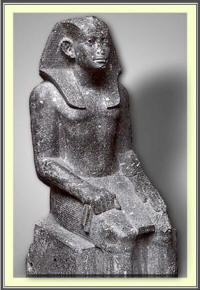 If
the Biblical numbers are taken literally the kings
during the enslavement and rise to power of Joseph would
be Senusret II, fig. 5, (1894-1878 BC) and Senusret III
(1878-1841 BC), of the 12th Dynasty. If
the Biblical numbers are taken literally the kings
during the enslavement and rise to power of Joseph would
be Senusret II, fig. 5, (1894-1878 BC) and Senusret III
(1878-1841 BC), of the 12th Dynasty.
-
This can be determined from
1 Kings 6:1, a verse
that dates the Exodus 480 years before the fourth year
of Solomon, c. 966 BC.
-
1 Kings
6:1 is seen as dating the Exodus to c. 1446 BC,
and Exodus 12:40 is
seen as placing the entrance of Jacob and his family
into an Egypt where Joseph holds high office
under the reign of Senusret III.
-
Joseph’s career as an Egyptian
governmental official would thus begin under Senusret II
and would continue into the reign of Senusret
III.
Joseph lived 71 years after his
family came to Egypt. This means that he died c. 1805
BC, during the reign of Amenemhet III
(1841-1797), approximately 25 years prior to the end of
the 12th Dynasty.
Specific examples from Joseph’s
life provide support for a 12th dynasty date.
Sold Into Egypt
(Genesis 37)
As we are told in
Genesis chapter 37
Joseph was sold by his brothers to a caravan of
Midianites for the price of 20 shekels of silver.
Interestingly enough, 20 shekels of silver was the
average price of a slave at that time.
-
In prior centuries the
price had been less, averaging 10 to 15 shekels, and by
the 15th century, 30 to 40 shekels. This is
further confirmation of this event occurring in the
early centuries of the 2nd millennium.
GE 37:28
Then some Midianite traders passed by, so they pulled
him up and lifted Joseph out of the pit, and sold
him to the Ishmaelites for twenty shekels of
silver. Thus they brought Joseph into Egypt.
Genesis
37:28 (NASB)
What is a shekel?
|
1 Shekel = 11.5 grams |
20 Shekel = 230 grams |
1 deben = 90 grams |
1 kit = 9 grams |
The following Egyptian texts,
listing the prices of slaves, have been discovered:
-
Iry-nofret paid the equivalent of
4 deben and 1 kit of silver (370 grams) for a Syrian
slave girl:
“…[As for me, I am the wife of
the District Overseer Sa-Mut], and I came to live in his
house, and I worked and [wove?] and took care of my
(own) clothes. In the year 15, 7 years after I had
entered the house of the District Overseer Sa-[Mut], the
merchant Ray approached me with the Syrian slave
Gemni-herimentet, while she was (still) a girl, [and he]
said to me: “Buy this girl and give me the price for
her”--so he spoke to me. And I took the girl and gave
him [the price] for her...4 deben, 1 kit of silver.”
-
In a letter from Amenhotep
III he orders 40 girls from Milkilu, the Canaanite
prince of Gezer, at 40 kit (360 grams) of silver each:
“Behold, I have sent you Hanya, the commissioner of the
archers, with merchandise in order to have beautiful
concubines, i.e. weavers; silver, gold, garments,
turquoises, all sorts of precious stones, chairs of
ebony, as well as all good things, worth 160 deben. In
total: forty concubines - the price of every concubine
is forty of silver. Therefore, send very beautiful
concubines without blemish.”
-
Another
Egyptian record found lists slaves valued at 3 deben and
1 kit (279 grams) each:
“His [slave] Pewer, son of...;
his slave Ebek, his slave Bupenamonkha; his slave
Neshenumeh; his slave, Dene; total of slaves: 6;
amounting at 3 deben 1 kit of silver each.”
Injustice in Egypt
(Genesis
39-40)
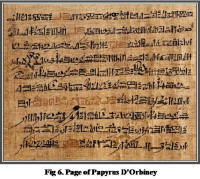 Joseph
was sold to Potiphar, officer of Pharaoh, by the
Midianites. He was placed in a position of trust.
Potiphar’s wife became attracted to him, sought to
entice him, and when he resisted her, had him thrown
into prison. Joseph
was sold to Potiphar, officer of Pharaoh, by the
Midianites. He was placed in a position of trust.
Potiphar’s wife became attracted to him, sought to
entice him, and when he resisted her, had him thrown
into prison.
-
A parallel
story is found in the Egyptian Tale of Two Brothers.
-
From the 19th
Dynasty, around 1185 BC, comes an Egyptian document, the
Papyrus D’Orbiney (fig. 6), which contains the “Story of
the Two
Brothers.”
-
The older
brother’s wife made an attempt to seduce the younger
brother while her husband was gone. When the young man
failed to submit to her lusts, she accused him to her
husband of having attempted to rape her. The outraged
husband immediately set out to kill his younger brother,
who was able to escape. Later the truth was found out,
and the unfaithful wife was killed.
-
Since Joseph
lived many centuries before the
Papyrus D�Orbiney
was composed, there is reason to suppose that the later
story depends upon the earlier.
-
Potiphar is
also called an Egyptian and commander of the king’s
guard in Genesis 39:1.
-
It is argued
that if the king were a Hyksos ruler, it would not make
sense for a native Egyptian to have been commander of
the royal bodyguard. Further, Joseph is described
several times (Gen 41, 42, and
45) as ruler over all the
land
of Egypt. The
Hyksos controlled only the northern part of Egypt, but
the 12th Dynasty ruled the entire nation.
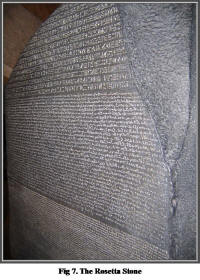 Joseph
also faced disappointment when he favored two of
Pharaoh’s servants, a butler (cupbearer) and a baker, by
interpreting their dreams. Joseph
also faced disappointment when he favored two of
Pharaoh’s servants, a butler (cupbearer) and a baker, by
interpreting their dreams.
-
The
interpretations were that the butler would be reinstated
to his former position within three days, while the
baker would be killed within that time
(Gen. 40:12-23). Both
predictions came true.
-
The titles
“butler” and “baker” derive originally from a time when
Pharaoh’s court was much simpler. By the time of Joseph,
these simple titles had come to refer to high government
officials.
-
Joseph had
specifically requested of the butler to try and affect
his release, but the butler promptly forgot Joseph’s
favor after Pharaoh reinstated him.
-
The titles
“cupbearer” and “baker” occur both in
Genesis 40 and Egyptian
texts.
-
A demotic
papyrus, now in the
British Museum, tells
how prisoners were freed on the anniversary of the
accession of Pharaoh, can be compared with
Gen 40:20.
-
The Rosetta
Stone (fig. 7) also indicates that Pharaoh had a custom
of releasing prisoners on his birthday, as the Pharaoh
did the butler in Genesis 40.
Honored in Egypt
(Genesis 41)
God intervened. Pharaoh
dreamed, the butler remembered Joseph, who was then
summoned to interpret the Pharaoh’s dream.
-
Joseph
interpreted Pharaoh’s dream that
Egypt would face seven
years of abundance followed by seven years of famine and
advised Pharaoh that he must find a man to store food
during the plentiful years in preparation for the lean
years.
-
Pharaoh
correctly appointed Joseph to the task
(Gen. 41:38-44) and
gave him authority next to that of Pharaoh himself.
-
The degree of
Joseph’s authority is revealed by the freedom he
exercised in making decisions, apparently without
consulting the Pharaoh. For instance, he set the price
the people were to pay for the food, even telling them
they could pay in animals when their money was gone and
later in land when their animals were gone
(Gen. 47:14-26).
-
Joseph’s
position as vizier, as described in
Gen 41:41–44, is
paralleled by records from
Egypt, and ancient
pictures showing the king in the act of placing golden
chains with pectorals around the necks of his high
officials.
-
Some scholars
have objected to the idea of Joseph, a Semite, being
elevated to such a high position in
Egypt.
-
However, a
letter dating from the Amarna period has been found,
written to a person in a similar position having a
Semitic name.
-
Joseph is
given the Egyptian name, Zaphenath-paneah, and an
Egyptian wife, Asenath, daughter of a priest of the god
Ra. Joseph was 37 years old at this time.
-
Joseph has
two sons by Asenath, Ephraim and Manasseh, who latter
took Joseph’s place as heads of Israelite tribes
(Gen. 41:50-52).
Under the work of Austrian archaeologist, Manfred
Bietak, at Tell el Daba and Qantir these two areas are
now the accepted locations of the Biblical city of
Ramses and the earlier Hyksos capital of Avaris. One
discovery, made between 1984 and 1987 is of extreme
significance for the 12th Dynasty historicity of the
Joseph Story.
-
A palace dating to the
12th Dynasty was found. There is no evidence that the
palace was a royal residence, but instead that of a high
government official who supervised international trade.
-
A cemetery was discovered
in the palace garden containing a number of tombs.
-
The largest and most
impressive tomb, consisting of a single brick chamber
with a small chapel in front of it, was oriented to the
structures of the 12th Dynasty. The tomb had been
robbed, but there was still found a damaged statue.
-
All that remained of the
statue were a few fragments of the head. The statue was
approximately 1 1/2 times life size, and exhibited no
characteristics of a royal person. What was interesting
is that this official was clearly an Asiatic as
demonstrated by the yellow coloration of the skin and
the mushroom hairstyle (fig. 8), both of which were
typical for the depiction of male Asiatics.
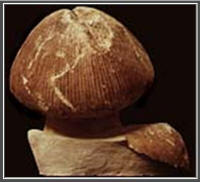 -
The significance of this
find for a 12th Dynasty setting of the Joseph Story is
obvious. There is not enough evidence to claim that the
tomb of Joseph has been found. But it is clear that this
man, without doubt a Canaanite of some kind, became a
very important official in the Egyptian government. He
was important enough to have lived in a major palace
complex. This demonstrates that an Asiatic could indeed
rise to a position of prominence in an earlier period
than the days of Hyksos rule, and allows us to accept
the biblical account that Joseph served a king of the
Middle Kingdom at almost exactly the same time as did
this Canaanite. -
The significance of this
find for a 12th Dynasty setting of the Joseph Story is
obvious. There is not enough evidence to claim that the
tomb of Joseph has been found. But it is clear that this
man, without doubt a Canaanite of some kind, became a
very important official in the Egyptian government. He
was important enough to have lived in a major palace
complex. This demonstrates that an Asiatic could indeed
rise to a position of prominence in an earlier period
than the days of Hyksos rule, and allows us to accept
the biblical account that Joseph served a king of the
Middle Kingdom at almost exactly the same time as did
this Canaanite.
Was the Pharaoh of
Joseph Egyptian or Hyksos?
Two points favoring the
idea that Joseph’s Pharaoh was Egyptian rather than
Hyksos are:
1.
Pharaoh gave
a wife to Joseph (Gen. 41:45)
from the priests of On (Heliopolis),
and these priests served the sun god Ra who was
disfavored by the Hyksos.
a.
The argument
is that a Hyksos king would have given Joseph the
daughter of the priest of another god, such as Seth, who
was a more important deity to the Hyksos than the native
Egyptian Gods.
2.
The
requirements of this Pharaoh appear Egyptian in that
Joseph shaved (Gen. 41:14)
before going to see him.
a.
Before Joseph
could appear before the king he had to take time to
shave himself (Gen 41:14).
Egyptians had clean-shaven faces, and the Egyptian story
of Sinuhe tells us how Sinuhe, returning to Egypt after
a long exile in Asia, first of all shaved and changed
his garments, so as to be considered once more a
civilized person.
b.
This would
reflect native Egyptian customs rather than those of the
Hyksos.
Do we find Joseph in
Egyptian Texts?
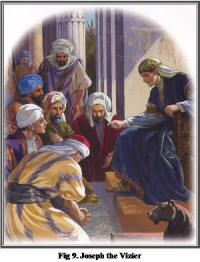 There
are a number of Biblical passages describing Joseph and
the duties he performed that only fit the job
description of Vizier. The Vizier, in the Middle
Kingdom, was the single most powerful man in Egypt aside
from the Pharaoh himself. For example: There
are a number of Biblical passages describing Joseph and
the duties he performed that only fit the job
description of Vizier. The Vizier, in the Middle
Kingdom, was the single most powerful man in Egypt aside
from the Pharaoh himself. For example:
-
Genesis 41:40, “Only in the throne will I be
greater than you.” This was true of only one person,
the Vizier.
-
Genesis 41:41, “I have set you over all the
land of Egypt.”
- In
Genesis 47:20, we have the story of the
purchase of the land of the nobility of Egypt by the
king. Joseph is the supervisor of this process. It
seems natural to view him as a powerful Vizier in
this verse and not as some lower official, since
ultimate responsibility over lesser governmental
officials rested with the Vizier. This incident is
probably the Biblical version of the weakening of
the provincial Monarchs, which took place in about
the middle of the reign of Senusret III.
If we accept as
probable that Joseph was Vizier, we next have to ask if
there is room for him in the list of Viziers of the
Middle Kingdom, and is there any evidence of his holding
that post?
-
First of all
there is very little information in any dynasty
concerning the Viziers.
-
For the
50-odd years of the reigns of Senusret II and
III
there is evidence of two Viziers, Sebekemhat and
Khnumhotep, both of whom should be dated to the reign of
the later Senusret
III.
There is another possible Vizier, Ameny, for the earlier
part of this period, but he cannot be confirmed or dated
with any certainty. There is therefore plenty of room
for Joseph to have served as Vizier in the 12th Dynasty.
-
There is no
reason to conclude that either Sebekemhat or Khnumhotep
was actually Joseph. There appears to be no similarity
between their names and the Hebrew version of Joseph’s
Egyptian name given in the book of Genesis.
-
There is one
interesting thing about the titles held by one of these
two Middle Kingdom Viziers. Khnumhotep held both the
titles of Vizier and Chief Steward of the King. He is
the only known person in Egyptian history to have done
so.
-
Perhaps, if
Joseph was Vizier and Chief Steward in the last years of
Senusret II and the early years of Senusret
III,
it is conceivable that after Joseph’s retirement,
Khnumhotep could have also have been granted both of
these high court positions.
-
At the very
least we see that the combination is a possibility in
the Middle Kingdom.
Israel in Servitude
(Exodus 1:8-22)
The king who “did not know about
Joseph” would have been one of the initial Hyksos
kings.
-
The Hyksos in the initial stages
of control ruled only northeastern Egypt and
established Avaris as the capital.
-
Goshen was in this area and no doubt was included
in the first stages of conquest. The time would have
been around 1730 BC, 75 years after Joseph’s death.
Slavery Imposed (Exodus
1:8-14)
 But
now matters changed. Slavery (fig. 10) was imposed on
the dwellers of Goshen. Exodus
1:8-10 records the reasons. But
now matters changed. Slavery (fig. 10) was imposed on
the dwellers of Goshen. Exodus
1:8-10 records the reasons.
-
The new ruler “did not know about Joseph”;
that is, he did not have historical knowledge of
Joseph, nor did he have reason to respect it if he
had. He headed a new dynasty of a foreign rule, so
that former allegiances or obligations were of
little consequence.
-
Second, Israelites were seen to be more and mightier
than the Hyksos. The new ruling family would not
have wanted a strong, unified, foreign group to
continue unchecked as a potential source of
trouble.
-
Third, a military alliance with the former regime
was seen as a possible way in which this trouble
might come. The deposed rulers, whose dynasty had
befriended this group of people, might now call upon
them for support in reestablishing their reign.
Accordingly, a decision was made to
enslave Israel.
-
Their potential for trouble
would be removed both by restricting freedom of
movement and by placing “slave masters” over them to
make sure that all energy was expended in hard labor.
This would not only keep them in control but also
provide valuable labor for building projects, such as
the cities of Pithom and Avaris, the new capital.
Male babies ordered killed
(Exodus 1:15-22)
In time another measure was
instituted to curtail Israel’s growth: all male
children were ordered killed. This order was not given
by the Hyksos, but by one of the 18th Dynasty
Pharaohs.
-
This follows from the fact that
Moses was born while the order was in effect.
-
Since Moses was 80 years old at
the time of the Exodus (1446 BC), his birth date may be
figured as c. 1526 BC, during the reign of Thutmose I
(1539 – 1514).
-
Thutmose I was the first great
empire builder of Egypt. It was a public order,
directed to every Egyptian, that all male children of
the Hebrews be thrown in the Nile to drown
(Exod. 1:22).
-
Thutmose I was involved in
enlarging Egypt’s borders, which meant that most
of his army was out of the country for extensive periods
of time. He did not want this foreign people to
increase and become still a greater threat while his
home force was so small.
While in Egypt, Abraham’s descendants grew to the
size of a nation. Up to this time fulfillment of God’s
promise of “descendants like the sands of the sea”
had been very slow, but during this period it was
very rapid. When Moses led Israel across Egypt’s border
at the time of the Exodus, Jacob’s 70 had become more
than 2,000,000.
Correlating Biblical history with
Egyptian history requires the establishment of two key
pieces of data:
- Duration of the Egyptian
sojourn
- The date of the Exodus.
-
Exodus 12:40
Exodus
12:40 gives 430 years for the Egyptian sojourn.
It reads:
EX 12:40
Now the time that the sons of Israel lived in Egypt was
four hundred and thirty years.
Exodus
12:40 (NASB)
-
Genesis 15:13
God predicted to Abraham that his descendants would be
would be “oppressed four hundred years.”
GE 15:13
God said to Abram, “Know for certain that your
descendants will be strangers in a land that is not
theirs, where they will be enslaved and oppressed four
hundred years.
Genesis
15:13 (NASB)
As to the figure used here being 400, rather than the
more exact 430 of Exodus 12:40,
this is a rounded number, something not uncommon in
Scripture.
-
Acts
7:6-7
Stephen used language similar to
Genesis when he spoke before the Sanhedrin and referred
to God’s warning that Israel would be treated ill in a
strange land 400 years.
AC 7:6
“But God spoke to this effect, that his
DESCENDANTS WOULD
BE ALIENS IN A FOREIGN
LAND, AND THAT THEY WOULD BE ENSLAVED AND MISTREATED FOR
FOUR HUNDRED YEARS.
AC 7:7
“ ‘AND
WHATEVER NATION TO WHICH THEY WILL BE IN BONDAGE I
MYSELF WILL JUDGE,’
said God, ‘AND
AFTER THAT THEY WILL COME OUT AND SERVE ME IN THIS PLACE.’
Acts 7:6-7
(NASB)
Since Stephen said essentially the
same thing as Genesis, similar arguments may be drawn
from his words.
-
Population Increase
In Numbers 1:2 God
commands Moses to take a census. According to
Numbers 1:45-46, there
are 603,550 men from 20 years and up able to go to war.
NU 1:45
So all the numbered men of the sons of Israel by their
fathers’ households, from twenty years old and upward,
whoever was able to go out to war in Israel,
NU 1:46
even all the numbered men were 603,550.
Numbers
1:45-46 (NASB)
-
Added to this should be an equal
number of women, 603,500.
-
Also added should be the number
of those under 20 years of age, normally 60% of those
over 20 (by modern day statistics), or 720,000.
-
This would make the total size of
Israel 1,920,000. The actual number was probably
between 2,000,000 and 2,500,000 because the ratio of
children was higher during this time than modern day
statistics, families tended to have large numbers of
children.
It would not be possible for Jacob’s family to multiply
to over 2,000,000 people in a period of less than 430
years. Mathematically this increase in 430 years is
possible under God’s blessing, the birth rate being kept
high, and the death rate low.
-
The historian Josephus (fig. 11)
also refers to Israel’s 400-year sojourn in
Egypt.
-
“And after four hundred
years did they spend under these afflictions; for they
strove one against the other which should get the
mastery, the Egyptians desiring to destroy the
Israelites by these labors, and the Israelites desiring
to hold out to the end under them.”
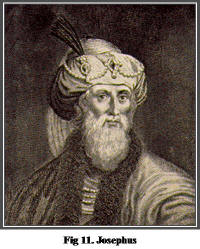 Joseph
died at the age of 110 (Gen.
50:26), 54 years after Jacob. His body was
embalmed and remained in Egypt until the Exodus, when
Israel took it along for final burial in Canaan
(Exod. 13:9). Joseph
died at the age of 110 (Gen.
50:26), 54 years after Jacob. His body was
embalmed and remained in Egypt until the Exodus, when
Israel took it along for final burial in Canaan
(Exod. 13:9).
In conclusion, we have attempted to
make the case that Joseph’s career fits well in the 12th
Dynasty, both Biblically and historically, and that
there is no good reason to try to place him in the later
Second Intermediate Period. He did make a significant
impact on Egyptian history, an impact that is reflected
in events such as the breaking of the power of the
Monarchs and the combining of the offices of Vizier and
Chief Steward of the King. As our knowledge of the
Middle Kingdom increases, and as new archeological
information from the delta is discovered and published,
we can expect to understand both the Middle Kingdom and
the Second Intermediate Period better, and we can expect
to expand our knowledge of the Egyptian background of
the Story of Joseph.
|


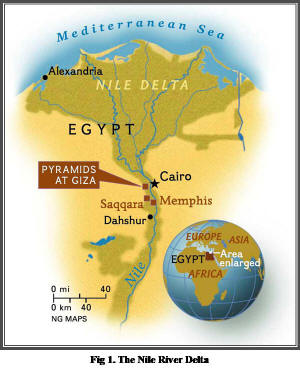 Looking
at a map of Egypt (fig. 1) you see a river that starts
near the equator and runs south to north, it is called
the Nile River. The Nile River runs north into the Nile
Delta and finally into the Mediterranean Sea.
Looking
at a map of Egypt (fig. 1) you see a river that starts
near the equator and runs south to north, it is called
the Nile River. The Nile River runs north into the Nile
Delta and finally into the Mediterranean Sea. 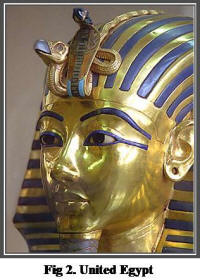 Upper
and Lower Egypt were independently ruled for many years.
It was not until c. 3000 BC that Upper and Lower Egypt
were united together.
Upper
and Lower Egypt were independently ruled for many years.
It was not until c. 3000 BC that Upper and Lower Egypt
were united together.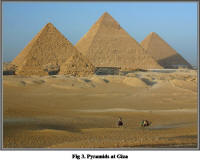 Delta
region.
Delta
region. -
- If
the Biblical numbers are taken literally the kings
during the enslavement and rise to power of Joseph would
be Senusret II, fig. 5, (1894-1878 BC) and Senusret III
(1878-1841 BC), of the 12th Dynasty.
If
the Biblical numbers are taken literally the kings
during the enslavement and rise to power of Joseph would
be Senusret II, fig. 5, (1894-1878 BC) and Senusret III
(1878-1841 BC), of the 12th Dynasty. Joseph
was sold to Potiphar, officer of Pharaoh, by the
Midianites. He was placed in a position of trust.
Potiphar’s wife became attracted to him, sought to
entice him, and when he resisted her, had him thrown
into prison.
Joseph
was sold to Potiphar, officer of Pharaoh, by the
Midianites. He was placed in a position of trust.
Potiphar’s wife became attracted to him, sought to
entice him, and when he resisted her, had him thrown
into prison. Joseph
also faced disappointment when he favored two of
Pharaoh’s servants, a butler (cupbearer) and a baker, by
interpreting their dreams.
Joseph
also faced disappointment when he favored two of
Pharaoh’s servants, a butler (cupbearer) and a baker, by
interpreting their dreams. -
- There
are a number of Biblical passages describing Joseph and
the duties he performed that only fit the job
description of Vizier. The Vizier, in the Middle
Kingdom, was the single most powerful man in Egypt aside
from the Pharaoh himself. For example:
There
are a number of Biblical passages describing Joseph and
the duties he performed that only fit the job
description of Vizier. The Vizier, in the Middle
Kingdom, was the single most powerful man in Egypt aside
from the Pharaoh himself. For example: But
now matters changed. Slavery (fig. 10) was imposed on
the dwellers of Goshen.
But
now matters changed. Slavery (fig. 10) was imposed on
the dwellers of Goshen.  Joseph
died at the age of 110
Joseph
died at the age of 110